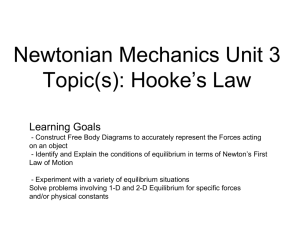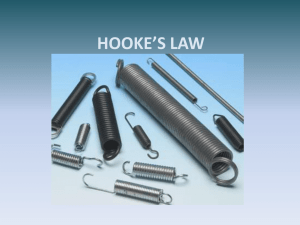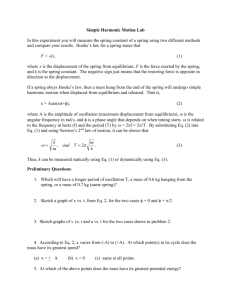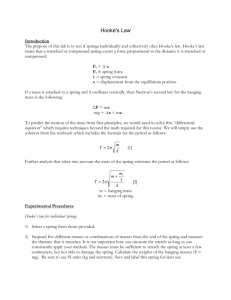Hooke's Law Lab (with Inquiry extension)
advertisement
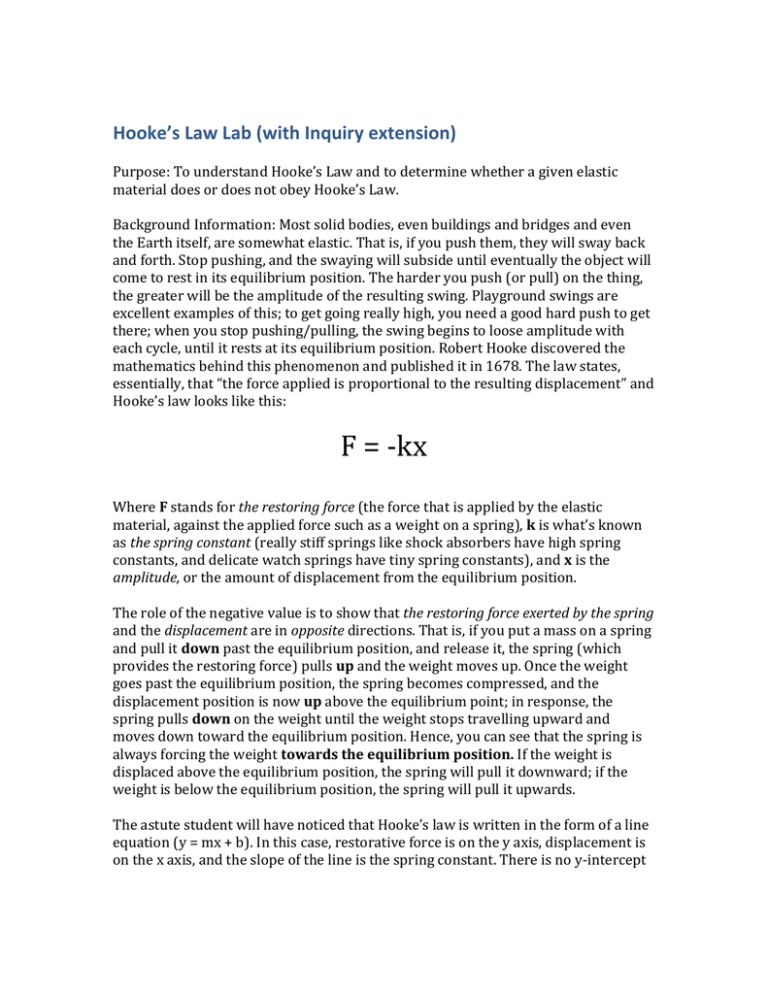
Hooke’s Law Lab (with Inquiry extension) Purpose: To understand Hooke’s Law and to determine whether a given elastic material does or does not obey Hooke’s Law. Background Information: Most solid bodies, even buildings and bridges and even the Earth itself, are somewhat elastic. That is, if you push them, they will sway back and forth. Stop pushing, and the swaying will subside until eventually the object will come to rest in its equilibrium position. The harder you push (or pull) on the thing, the greater will be the amplitude of the resulting swing. Playground swings are excellent examples of this; to get going really high, you need a good hard push to get there; when you stop pushing/pulling, the swing begins to loose amplitude with each cycle, until it rests at its equilibrium position. Robert Hooke discovered the mathematics behind this phenomenon and published it in 1678. The law states, essentially, that “the force applied is proportional to the resulting displacement” and Hooke’s law looks like this: F = -kx Where F stands for the restoring force (the force that is applied by the elastic material, against the applied force such as a weight on a spring), k is what’s known as the spring constant (really stiff springs like shock absorbers have high spring constants, and delicate watch springs have tiny spring constants), and x is the amplitude, or the amount of displacement from the equilibrium position. The role of the negative value is to show that the restoring force exerted by the spring and the displacement are in opposite directions. That is, if you put a mass on a spring and pull it down past the equilibrium position, and release it, the spring (which provides the restoring force) pulls up and the weight moves up. Once the weight goes past the equilibrium position, the spring becomes compressed, and the displacement position is now up above the equilibrium point; in response, the spring pulls down on the weight until the weight stops travelling upward and moves down toward the equilibrium position. Hence, you can see that the spring is always forcing the weight towards the equilibrium position. If the weight is displaced above the equilibrium position, the spring will pull it downward; if the weight is below the equilibrium position, the spring will pull it upwards. The astute student will have noticed that Hooke’s law is written in the form of a line equation (y = mx + b). In this case, restorative force is on the y axis, displacement is on the x axis, and the slope of the line is the spring constant. There is no y-intercept in this equation, but there might for the line that appears on your graph, depending on the data that you graph. Not all elastic materials are Hooke-type materials, and even those that are will only obey Hooke’s Law within certain limits. If you pull too hard on a spring, it will become deformed, the coils will not go back together, and it will no longer obey Hooke’s Law. Here’s an overview of what you will be doing and what you need to turn in: 1. Graph a given set of data 2. Answer questions about the graph you generated 3. Conduct your own investigation to answer a research question and write a lab report. You will turn in everything together as one paper. Title your lab report “Hooke’s Law Lab” and be sure to title each section with the step number and name so that I know what I am looking at. Step 1: Graph given data Here is data from an experiment with a spring that does obey Hooke’s Law. Somebody put different masses on a spring and let the spring extend downward until the applied weight was equal to the restoring force of the spring and the weight hung motionless. So, although the spring’s restoring force is not something that can be directly measured, it can be determined from the mass that is hanging from the spring; it is equal to the weight that is attached to the spring. Image courtesy of Wikipedia, http://en.wikipedia.org/wiki/Hooke's_law Here is the data generated in the experiment: Weight vs Stretch Distance in a Spring Stretch Distance (m) Weight applied to spring(N) 0.0 0.0 0.30 1.9 0.60 3.7 0.90 6.3 1.2 7.8 Data courtesy of Physics Principles and Problems, McGraw Hill, 2013 Graph the data so that your line equation correctly matches the form showed in Hooke’s Law Equation. Draw in a best-fit line to match the data. Step 2: Analyze the Graph Below your graph, answer the following questions: 1. Write the line equation for this specific graph. Do not write “y = mx + b,” that’s a general equation. Instead, fill in the generic values given in the equation with the specific things those values stand for in this graph. Instead of “y,” write what is represented on the y axis. Instead of “x,” write what is 2. 3. 4. 5. represented on the x axis. Instead of “m,” write what the slope represents. In this case, the slope represents something about the nature of the spring. What is the spring constant of this spring? To find the answer: Compare the line equation that you wrote above to the equation for Hooke’s law to determine what aspect of the graph you need to determine. The y-intercept of your graph should be zero. What does a zero yintercept mean in terms of the experiment, why does this make sense? As you can see, both force and distance are present on this graph. Remember that Fd = Work. In this case, gravity does work to pull the mass down, and that energy is stored in the spring as potential energy. You can determine the amount of elastic potential energy stored in the spring by finding the area under the curve (which in this case is a straight line, if you drew your graph correctly). How much potential energy is stored in the spring when the weight applied = 5 N? Rewrite the geometric equation you used to solve #4 to reflect the physics of the potential energy stored in a spring. Do this the same way that you rewrote the generic line equation to fit this particular graph. Instead of writing “area of a triangle,” for example, you will write “elastic potential energy,” etc. Step 3: Investigate In this portion of the activity, I will give you an elastic material and you will determine whether or not it obeys Hooke’s Law. In your lab report, be sure to include: your research question a data table a graph answer the research question (please justify/explain your answer, don’t just say “yes it obeys Hooke’s Law” or “no it doesn’t obey Hooke’s Law.”)
